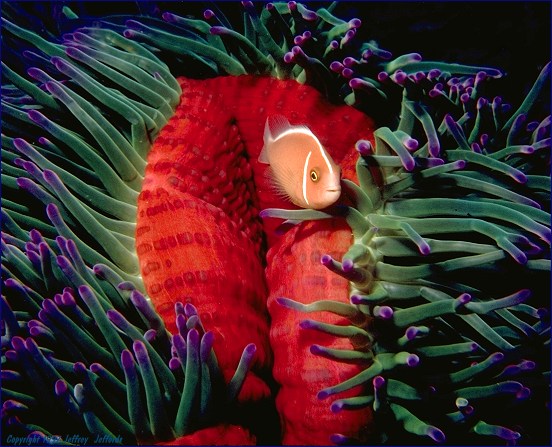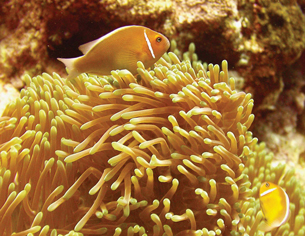Adaptation
As any organism evolves, it also evolves new adaptations.
These adaptations are how the organism readjusts to the
surrounding environment in which it inhabits. The main types of
adaptation we focus on for the Amphiprion perideraion are ones
that enhance form and function. A big adaptation for A.
perideraion is its symbiosis with the giant sea anemone that the
clownfish resides in (Murata et al., 1986).

The pink skunk clownfish appear to have chemicals that allow
this symbiosis (Murata et al., 1986). This is one of the
functions that A. perideraion does for protection. Not only is
it protecting itself from the sting of the anemone by living in
the anemone, it is protecting itself from other predators.
Another way this marine fish protects itself is its swimming
pattern. A. perideraion has distinct swimming patterns as well
as prey search patterns (Coughlin et al., 1992). The pink skunk
clownfish swims around in different variations to protect itself
from predation of larger fish (Coughlin et al., 1992). Another
reason for changing swimming pathways is for adequate food
acquisition (Coughlin et al., 1992).
When the clownfish does a local search for food, it will swim in
patterns with a reduction in its speed (Jander, 1975). The
search patterns will become more intense and complicated as the
prey density increases (Coughlin et al., 1992). The patterns
that are considered more complex for searching are ‘tangles,
loping, intersecting paths without straight lines’ (Jander,
1975). When the fish does these types of patterns and speed
reduction, they are maximizing the time spent in the area with
higher concentrations of prey, and ultimately nutrients for them
(Coughlin et al., 1992).

As Amphiprion perideraion grows from larval stage to adult form,
its body size will naturally increase. There is not much insight
on the lifespan of this type of clownfish, but it will reach the
full growth expectancy a little after a year and a half (Fautin
et al., 2010). It reaches a maximum length of 10 cm (Fautin et
al., 2010). The female will ultimately be larger then the male
(Hattori, 2000). In most forms of clownfish, the female will be
larger then the male, to aid in the process of fertilization and
egg carrying/laying (Hattori, 2000). As discussed in the
reproduction page, A. perideraion will switch sexes to aid in
reproduction (Hattori, 2000).
The pink skunk clownfish is a pinkish orange color, with a white
stripe on its dorsal side from the head to the tail. With this
coloration, they are distinct from other clownfish, while also
maintaining species similarities, and are a vibrant color like
many of the other marine organisms that live in an environment
that is symbiotic with a sea anemone.
Back to Home
Continue to Reproduction
